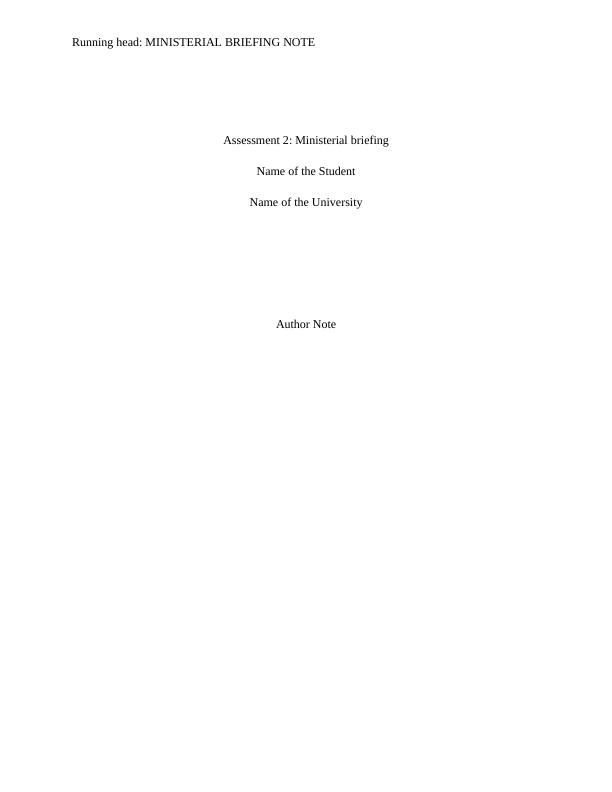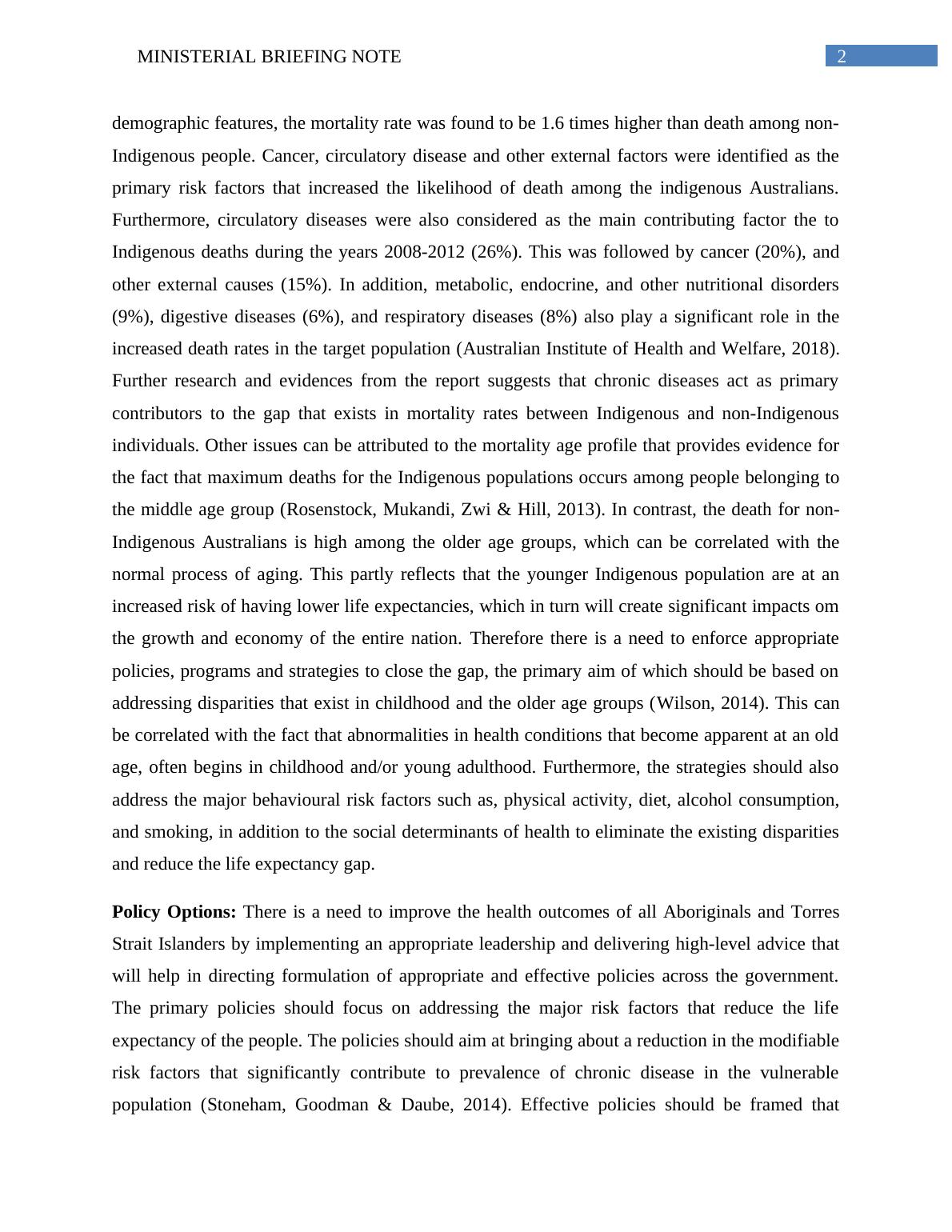The Portrayal of Indigenous Health in Selected Australian Media - PDF
6 Pages1631 Words55 Views
Added on 2021-06-14
The Portrayal of Indigenous Health in Selected Australian Media - PDF
Added on 2021-06-14
ShareRelated Documents
Running head: MINISTERIAL BRIEFING NOTEAssessment 2: Ministerial briefingName of the StudentName of the UniversityAuthor Note

1MINISTERIAL BRIEFING NOTEUrgency: Report on increasing indigenous life expectancyTo: The Health MinisterFrom: Senior Official, Health DepartmentDate: 04.05.2018Subject: Ministerial briefing note for suggesting policies to increase indigenous lifeexpectancyPurpose: The purpose of the briefing report is to suggest recommendations related to effectivepolicies that must be implemented by the government to close the existing life expectancy gapsfor all indigenous AustraliansBackground: The Closing the Gap report was established by the Council of AustralianGovernments (COAG), with the aim of bringing together several evidence-based researches thatfocuses on overcoming potential disadvantages for the Indigenous Australians. The report is acollection of evidences that have been systematically analysed and synthesized, for reachingconcrete conclusions about the policies and rules that might work in this context(Commonwealth of Australia,2018). The report is based on the basic fact that indigenousAustralians have demonstrated a reduction in their life expectancy of approximately 10 years lessthan their Australian counterparts (Australian Institute of Health and Welfare, 2018). Theresilience and cultural strength of the Aboriginals and Torres Strait Islanders have been found toplay a significant role in developing pathways that will heal and address the trauma that havebeen faced by the indigenous people since years. Thus, the closing the gap initiative wasformulated with the aim of providing a framework that will help to bring about holisticimprovement of the indigenous people, thereby enhancing their health outcomes. The primaryaim of the government should be directed at working together with the healthcare professionalsin order to empower and enable the Aboriginals and Torres Strait Islanders to live a prosperousand healthy life (Zhao, Wright, Begg & Guthridge, 2013). Issues: From the period 2008-2012, approximately two-thirds (65%) of Indigenous Australianshad died before the age of 65, upon comparison with 19% deaths of their non-Indigenouscounterparts. Following an adjustment of the differences that existed in age and other

2MINISTERIAL BRIEFING NOTEdemographic features, the mortality rate was found to be 1.6 times higher than death among non-Indigenous people. Cancer, circulatory disease and other external factors were identified as theprimary risk factors that increased the likelihood of death among the indigenous Australians.Furthermore, circulatory diseases were also considered as the main contributing factor the toIndigenous deaths during the years 2008-2012 (26%). This was followed by cancer (20%), andother external causes (15%). In addition, metabolic, endocrine, and other nutritional disorders(9%), digestive diseases (6%), and respiratory diseases (8%) also play a significant role in theincreased death rates in the target population (Australian Institute of Health and Welfare, 2018).Further research and evidences from the report suggests that chronic diseases act as primarycontributors to the gap that exists in mortality rates between Indigenous and non-Indigenousindividuals. Other issues can be attributed to the mortality age profile that provides evidence forthe fact that maximum deaths for the Indigenous populations occurs among people belonging tothe middle age group (Rosenstock, Mukandi, Zwi & Hill, 2013). In contrast, the death for non-Indigenous Australians is high among the older age groups, which can be correlated with thenormal process of aging. This partly reflects that the younger Indigenous population are at anincreased risk of having lower life expectancies, which in turn will create significant impacts omthe growth and economy of the entire nation. Therefore there is a need to enforce appropriatepolicies, programs and strategies to close the gap, the primary aim of which should be based onaddressing disparities that exist in childhood and the older age groups (Wilson, 2014). This canbe correlated with the fact that abnormalities in health conditions that become apparent at an oldage, often begins in childhood and/or young adulthood. Furthermore, the strategies should alsoaddress the major behavioural risk factors such as, physical activity, diet, alcohol consumption,and smoking, in addition to the social determinants of health to eliminate the existing disparitiesand reduce the life expectancy gap. Policy Options: There is a need to improve the health outcomes of all Aboriginals and TorresStrait Islanders by implementing an appropriate leadership and delivering high-level advice thatwill help in directing formulation of appropriate and effective policies across the government.The primary policies should focus on addressing the major risk factors that reduce the lifeexpectancy of the people. The policies should aim at bringing about a reduction in the modifiablerisk factors that significantly contribute to prevalence of chronic disease in the vulnerablepopulation (Stoneham, Goodman & Daube, 2014). Effective policies should be framed that

End of preview
Want to access all the pages? Upload your documents or become a member.
Related Documents
Exploring the impact of Policy on Health | Essaylg...
|9
|2526
|15
CVD Health Promotion Amongst aboriginal Report 2022lg...
|10
|2850
|24
Closing the Gap Policy and its Impact on Aboriginal and Torres Strait Islander Healthlg...
|10
|2527
|101
Closing the Gap Policy and its Significance to Indigenous Australianslg...
|9
|2301
|364
Aboriginal and Torres Strait Islander deaths are significantly more likely to die in their native Australians than their non-indigenous counterpartslg...
|8
|1791
|165
Aboriginal and Torres Strait Islander Peoples' Healthlg...
|9
|2839
|472
